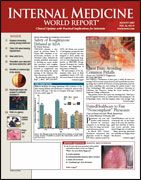Publication
Article
Internal Medicine World Report
A1c Test May Soon Be Reported in New Units
Author(s):
New Average Glucose Measure Helpful for Patients
By Wayne Kuznar
CHICAGO—A measure of glucose control may soon be expressed in average glucose units in addition to the current standard by which hemoglobin A1c is expressed in percentage units.
With confirmation that the A1c measure truly does indicate average blood glucose over time, international authorities are hoping to introduce a new A1c calibration methodology. The technology will allow physicians to report A1c results to patients in the same units they are already using for glucose self-monitoring, which is expected to enhance physician?patient communication, said David Nathan, MD, at the American Diabetes Association annual meeting.
David Nathan, MD
It had been assumed that A1c values closely correlated with average blood glucose, but this correlation had never been proven, said Dr Nathan, director of the General Clinical Research Center and the Diabetes Center at Massachusetts General Hospital, and a professor of medicine at Harvard Medical School. In order to ascertain that the A1c assay reflected long-term glycemia, a study is being undertaken in which continuous/frequent blood glucose monitoring is compared with A1c.
"Previous studies [to correlate A1c with glucose control] used infrequent blood glucose monitoring," said Dr Nathan. "But we know that blood glucose levels fluctuate constantly. Does an A1c of 5% equal 80, 90, or 100 mg/dL? We wanted to know if A1c is a true average blood glucose level."
The relationship between average blood glucose levels and A1c is being studied at 10 centers. Thus far, 650 of the hoped-for 700 volunteers have been recruited. The goal is to recruit 300 patients with type 1 diabetes, 300 with type 2, and 100 without diabetes.
Patients are having their A1c levels measured monthly for 5 months, and their average glucose levels measured using a combination of continuous glucose monitoring and frequent fingerstick glucose levels equivalent to self-monitored blood glucose.
From the first 250 patients who completed the study, "as we had hoped, there is a tight correlation between average blood glucose and A1c," said Dr Nathan. In transforming A1c values into average blood glucose, he said that an A1c of 8% represents an average blood glucose value of about 180 mg/dL.
"What we're doing is converting an A1c into units that have more significance to patients—one that they're already using in their day-to-day glucose monitoring," said Dr Nathan.
The A1c test measures the amount of glucose that has attached to a portion of the hemoglobin molecule, and that is why the test may be confusing to patients, said Mitchell Scott, PhD, professor of pathology and immunology, Washington University, St. Louis. "If you have diabetes, you have a glucose problem, not a hemoglobin problem," he said. "Doesn't glucose mean more to you than hemoglobin?"
Key Points
- If the final results replicate the preliminary findings, physicians will likely soon report A1c test results in average glucose units.
- This would allow A1c values to be converted into units that have more significance to patients.
Physicians will still see A1c percentages reported when they do the assay, said Dr Scott. But in addition they'll also have the results reported in units that reflect the new reference method. Therefore, the end user will see little difference, other than additional ways for the A1c test results to be reported.
Should the new measure become available, "we will push the average glucose aggressively in patient education," said Richard Kahn, PhD, chief medical and scientific officer at the American Diabetes Association.
The study is scheduled to be completed by September, and a final report will be presented at the annual meeting of the European Association for the Study of Diabetes.





